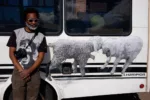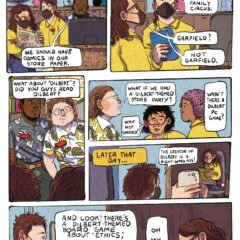
“I am darkness, I am the night, I am Batman!” Or rather a dual practice artist.
I offer no advice here. This column is a tragic lamentation in having a dual art practice – not a multimedia practice as many painters and sculptors have, but a practice that is dual — art and comics. I wholeheartedly believe most (comic) artists will relate.
Being as I did not receive any art questions in the inbox this month, I am culling this month’s advice column straight from my Twitter feed. Generally, one comment on my tweets is the equivalent of going viral, so when I tweeted “Sorry most of the time that comic artists try to make art they FAIL, it’s gross, please stop — just make your comics those are art. Damn,” then in true cis white male fashion “Twitter” chimed in to say “WRONG.” (Don’t be mad, I’m a cis white female for saying sorry at the beginning of a tweet & for saying cis white anything ok?) To my credit, thanks, I said most, not all and in true Lacanian fashion; chill bro, I’m merely just projecting.
My tweet was in response to a (comic) artist’s exhibit which was a departure from comics into a waste of exhibition space (yeah, I’m jealous.), a thoughtless sculptural exploration of the uncanny valley* in comic form that within the context of contemporary art has been done…a lot. It’s just that I think your comics are art, ok. The exhibit shall remain nameless because why be a b*tch. I see this a lot with comic art and art – an uneasy separation. Comic artists consistently want to crossover into art and vice versa artist to comic artist or altogether attempt a dual art practice. No venn diagrams in this article, I promise.
Let me be explicitly clear because this is confusing. Comics are ART. Comics = Art. What I am theorizing in this article is that comics and art function in different head spaces. A drawing is not a comic, a painting is not a comic, a sculpture is not a comic. Why? Because when you are drawing comics, you are writing. Now ok, you want to make comics with sculpture – you can absolutely do this if you are applying writing to sculpture. Does this make sense? No? Well, you’re not thinking like a comic artist.
Onwards.
It was brought up in my Twitter thread some (comic) artists easily bridge this gap, like Mat Brinkman, Paper Rad, Brian Chippendale and so on from the Fort Thunder days. Or how about Ad Reinhardt** made comics??? Waahhh? Yeah, they’re about art. Or German-American Expressionist painter Lyonel Feininger?*** His paintings and comics look like they are done by two unrelated people. It’s actually eerie. One (comic) artist in particular that has discussed the duality of a comics and art-making practice is Jaakko Pallasvuo, an artist consistently at odds with themself, expectedly. I especially admire Pallasvuo’s comics for their ease in composition, painterly comic styling and philosophical underpinnings. I couldn’t find the exact interview that I read in 2014, but please go on to read here about Pallasvuo discussing coming back to comics and, feeling like me, Jaakko writes, ”It doesn’t feel so integrated with the art thing, it feels like two separate things.”

I struggle. I find myself being two different people between making comics and making art. I am two people. One person is introverted, drawing in their bedroom and the other person is extroverted performing guerrilla performance art with a kazoo in public spaces. I have two separate “communities” *barf* comics friends and art friends who occasionally cross paths. I have two separate sections of my patreon. People consistently remind me they like my comics more so than my performance art, which, hey, is totally cool – performance artists all know no one likes us *musical notes* we don’t care.
I would venture a good number of my comic friends don’t know as much about art as I do or are not privy to local art scenes; and I do not know nearly as much about comics and the comics scene as my comic friends. I have been more invested in art both financially (art school) and in practice, while drawing comics has always been something I’ve done my whole life by pure instinct. My main comics gig isn’t sourced from the comics scene, it’s on an ARTblog. Getting an art exhibition doesn’t happen out of thin air and same goes for getting your comics published and building an audience. You need to be present in both scenes, which more often than not, do not interact. I’m not saying you can’t be a part of both and be successful – I’m saying it’s double the work and you most likely end up marginally successful in both. You can be equally schooled in both comics and art, and even write nihilistic, poignant, funny comics about the art world like in Walter Scott’s “Wendy”, but – the comics and art worlds are separate. Walter Scott also makes art that sometimes experiments in displaying comics by adding a sculptural component (see image right below).

The world is big, and so is the art world and the comic world. Both the latter have many subsets of existence, and within that there’s a comics section for art. A large pool of indie comic artists are keen to reference, create narratives about art. Like “Art School Confidential”, Daniel Clowes’s endearing take on the fruitless pursuit. An aside, I hate, yeah hate, the term art comics. It’s pretentious. I hope (comic) artists eradicate this predilection towards late-capitalism and take this category away all together. That said, there’s art comics.
Drawing comics is an intensive studio practice. You need to ABD, always be drawing. In this way you can say it’s like painting. Times when I’m sewing a costume for a performance, practicing a performance, brainstorming or making a crap sculpture to make fun of post-internet art, I find that I’m being pulled in half, like I should be drawing. It feels like lost time. I’m anxious about this actually. I schedule drawing time to take away from this anxiety. I find myself at odds in taking the time to study (reading) comics as time I’m not reading about Political Performance Art in the 20th century or Queer Theory in Art Criticism or Community Practice (I made these up, but pretty spot on). I feel like both parts of my artist self suffer because in order to do them one is being neglected for the other. I’m like a bad mom (who does not have a baby). There’s just not enough time in the day!
All this said, does that mean comic artists can’t make art or artists make comics? No way! But can they? In short my comic peers are making better comics than me. On the other side of things, when comic artists take a hack at art without taking into account an entire field of contemporary art practice – it shows. I’m self-aware that this sounds like gatekeeping. So what? Just kidding. I don’t even have an MFA. This (gatekeeping) also sounds like something I bet ceramists feel about painters. Lol What I’m advocating to acknowledge is that comics and art are separate for the sake of admiring them as such, not to exclude anyone from the pursuit.
On a philosophical level, irl, I subscribe to monism not dualism (sorry not sorry, Descartes) obviously because I’m not going to stop making both art and comics. I genuinely believe artists and comic artists are all making the “art” and one feeds into the other, and we should all be exhibiting together forever. And anyway I got into comics more so because I can’t afford paint. The path paved towards art making is laid by necessity from the financial standing of an artist.
The dual art practice extends even beyond the comic and art combo. I’m thinking the distinct difference is in the writing – like the difference between a novelist and an artist. People (me) are surprised Victor Hugo**** was a sick comic artist, draughtsman, technically. I’m skeptical that for me making comics is a good thing because I’m not fully present in a dual art practice that it is two distinctly different art practices. Am I always giving just half of myself? Even Bruce Wayne slowly becomes more Batman.
When it comes to exhibiting comics, I’m (me) not compelled to frame them and put them in an art gallery. I want to post them online, print them and hand them out (for cheap). I don’t think of my comics as art objects. I enjoy seeing inks in person, but as an artist and comic artist if given a white walled space to exhibit, I wouldn’t hang my comics. (Maybe have an artist book exhibition.) Never say never, but essentially, the functions are different: a comic: the pages fold; an art object: framed in space or planted on a pedestal; a performance, an action. And rightly so, the art making that results in the final product for comics, art, performance is different, so the presentation should be different for each.
Best,
Beth, I am two or three people.
Ask Artblog is the essential advice column for all your art life questions. Beth Heinly and Dave Kyu, our Advisors-In-Chief, offer solid advice from life experience and mature opinions on issues. Have a question for Dave or Beth? Email ask@theartblog.org. Or click here to submit a Google form with your questions.
Glossary
* Uncanny valley – In aesthetics, the uncanny valley is a hypothesized relationship between the degree of an object’s resemblance to a human being and the emotional response to such an object. The concept of the uncanny valley suggests humanoid objects which appear almost, but not exactly, like real human beings elicit uncanny, or strangely familiar, feelings of eeriness and revulsion in observers.
** Ad Reinhard’s comics in his book, “How to Look”
*** Lionel Feininger’s comics









